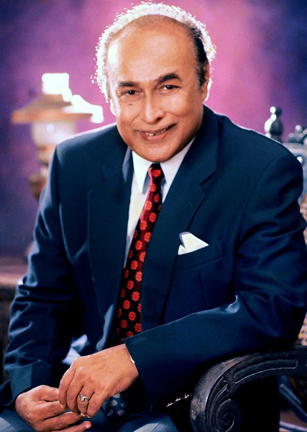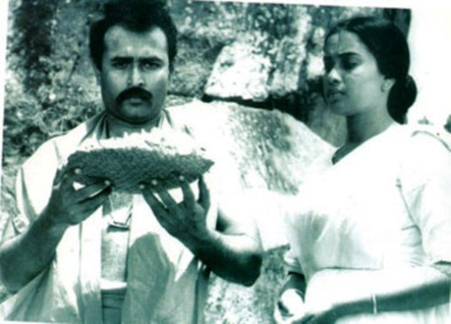The actor’s actor
A tribute to legendary actor Gamini Fonseka whose
80th Birth Anniversary fell last week:
by Pramod de Silva
The year: 1971.
The film: Neil Rupasinghe’s Hathara Denama Surayo (Four Champions).
 The house is full, the lights go out and the silver screen comes to
life. As the opening credits fade away, a dashing young man emerges on
the screen with his trademark smile and bravado. No villain will want to
grapple with this muscular epitome of youth. The audience is silent at
first and then roars to life – whistles, energetic clapping and the real
name of that young man reverberate throughout the darkened cinema,
drowning out even the soundtrack. The house is full, the lights go out and the silver screen comes to
life. As the opening credits fade away, a dashing young man emerges on
the screen with his trademark smile and bravado. No villain will want to
grapple with this muscular epitome of youth. The audience is silent at
first and then roars to life – whistles, energetic clapping and the real
name of that young man reverberate throughout the darkened cinema,
drowning out even the soundtrack.
The women in the audience, heavily outnumbered by the men, cannot
probably express their feelings for they have been rendered speechless
after getting a glimpse of that enigmatic smile, that handsome face. And
who can dislike that deep, surreal voice, which was ably complemented by
H.R. Jothipala in the playback songs?
Far and away
Just a few minutes into the movie, the audience has already got what
it wanted – Gamini Fonseka, the actor’s actor and doyen of Sinhala
cinema. They come especially to see him from far and away, to cheer him
on for the next two hours as he smashes the brutish villains to
smithereens and finally gets the girl he always wanted. It is an
experience they would remember as long as they live.
The year: 1972.
The film: Lester James Peries’ Nidhanaya (Treasure).
The audience is transfixed as the very same Gamini Fonseka, playing
the character of Willie Abeynayake, stabs the on-screen character
portrayed by Malani Fonseka and waits until the access door to a
legendary and valuable treasure opens. Of course it does not. Gamini
seamlessly expresses the full gamut of human emotions ranging from
surprise to shock to grief as he finally realises the sheer futility of
his mission. This time, the entire audience is speechless.
That was Gamini Fonseka in a nutshell – a multifarious actor who was
equally at home in commercial and art house roles. With his strong
personality, he could easily transform himself into whatever character
demanded by the director and give his 100 per cent or even more.
Eschewing the Indian style of acting that was embraced by most
contemporary actors; he evolved a uniquely Sri Lankan style of acting
that local audiences could easily identify with. He was without doubt
one of the best actors in the whole of Asia, on par with the best of the
best, including the legendary Japanese actor Toshiro Mifune. They even
had a passing resemblance to each other.
In a career spanning four decades, Gamini acted in nearly 110 films,
86 of which featured him as the lead actor. Among the most well-known
films starring Gamini are ‘Sandeshaya’, ‘Ran Muthu Duwa’ (the first
Sinhala colour movie), ‘Gamperaliya’, ‘Getawarayo’, ‘Chandiya’,
‘Senasuma Kothanada’, ‘Sigiri Kashyapa’, ‘Parasathu Mal’, ‘Sorungeth
Soru’, ‘Sura Chawraya’, ‘Mee Masso’, ‘Welikathara’, ‘Baduth Ekka Horu’,
‘Paaraa Walalu’, ‘Ohoma Hondada’, ‘Sahanaya’, ‘Edath Suraya Adath Suraya’,
‘Adare Hithenawa Dekkama’ (the titular song is still a hit), ‘Hondata
Hondai’, ‘Kasthuri Suwanda’, ‘Awa Soya Adare’, ‘Hulavali, Yakadaya’,
‘Deviyani Oba Kohida’, ‘Minisun Athara Minisek’, ‘Sarungale’ (where he
played the role of Tamil clerk Nadarajah), ‘Uthumaneni’, ‘Sankapali’, ‘Thawalama’,
‘Sagarayak Meda’, ‘Sakvithi Suvaya’, ‘Pooja’, ‘Nomiyena Minisun’,
‘Pavana Raluwiya’, ‘Demodara Paalama’ and ‘Anthima Reya’.
He sat in the director’s chair for 10 films and his directorial debut
was a critical and commercial success. The movie, ‘Parasathu Mal’
(Forbidden Flowers) became an instant classic, though Gamini portrayed
an extremely nauseating character called Bonnie Mahaththaya. After a
15-year hiatus, his next directorial effort came in 1980 with ‘Uthumaneni’.
‘Mayurige Kathawa’, ‘Sagarayak Meda’, ‘Re Manamali’, ‘Sakvithi Suvaya’,
‘Koti Waligaya’, ‘Nomiyena Minisun’ and ‘Anthima Reya’ were among his
other directorial efforts. He also acted in some of these films, letting
others shine in the rest.
Gamini’s films are known for their exceptional cinematography, which
is not surprising given the fact that he was a good cameraman as well.
Thus in his mind’s eye he could conjure up the best angle for a
particular shot and instruct his cameraman accordingly. He also produced
two movies – ‘Sorungeth Soru’ and ‘Sahanaya’. He acted in both films.
Gamini had a starring role in ‘It’s a Matter of Time’ an English film
produced in Sri Lanka and also the Sinhala teledrama ‘Kalu Saha Sudu’
(Black and White), his sole foray into television. There is no record of
Gamini taking to the drama stage as a professional actor (he did act in
a stage play titled ‘Mayuri’ as a schoolboy), but he was an avid watcher
of well-known stage plays. Another little known fact is that Gamini was
a poet and a songwriter, who wrote the lyrics for playback songs in
‘Sarungale’ (Kite) and ‘Mayurige Kathawa’ (Mayuri’s Story).
Gamini was no stranger to controversy and some of his films contained
his ‘take’ on political and other issues of the day. ‘Koti Waligaya’
focused on the Northern conflict, while ‘Sagarayak Meda’ and
‘Uthumaneni’ had a political message.
He worked with all the leading directors, but had a very close
relationship with Dr. Lester James Peries, with whom he initially worked
on the critically acclaimed breakthrough film ‘Rekhava’ (Line of
Destiny) as Second Assistant director. Coincidentally, Gamini was an
‘extra’ in ‘Rekhava’. Gamini also had a role in Lester’s ‘Muhudin
Gedarata’ documentary.
|

Gamini and Malani in Nidhanaya |
Their partnership would last several decades. Gamini also had a hand
in David Lean’s masterpiece ‘Bridge on the River Kwai’, which was filmed
entirely in Kithulgala. Incidentally, Gamini did only one film each with
directors K.A.W. Perera (‘Sanasuma Kothanada’) and Titus Thotawatta (‘Chandiya’).
Gamini’s acting excellence was widely recognised here and abroad. He
won the Best Actor award for his role as Jinadasa in ‘Gamperaliya’, just
five years after his acting debut in a minor role in ‘Daiwa Yogaya’
(1959).
He won the Sarasaviya Best Actor Awards for his roles in ‘Dheewarayo’,
‘Parasathu Mal’, ‘Sorungeth Soru’, ‘Sarungale’, ‘Uthumaneni’, ‘Sagarayak
Meda’, ‘Yuganthaya’ and ‘Nomiyena Minusun’. ‘Yuganthaya’ also netted him
a Presidential Award for Best Actor as did D.B. Nihalsinghe’s ‘Welikathara’,
in which he portrayed the role of Police ASP Wickrema Randeniya. He also
won the Sarasaviya Most Popular Actor Award on several occasions and the
highly coveted Rana Thisara Award.
Undisputed king
Gamini’s fellow actors and actresses and the technical crew held him
in high esteem as the undisputed king of local cinema. He always took
pains to ensure that the technical crew received all due facilities.
Once, when the producers had secured accommodation only for the actors
but not for the crew during an extended shooting session in Dambulla, he
left in disgust and returned only when he was assured that equally good
accommodation would be found for the technical crew as well.
He acted with all the leading ladies of the Sinhala silver screen
from Malani Fonseka to Sandhya Kumari and all leading main and
supporting actors. While it was excruciatingly painful to portray a
villain in a film starring Gamini Fonseka because some of the fight
sequences were real, Gamini got on like a house on fire with all the
‘villainous’ actors including Dommie Jayawardena.
Gamini always appreciated the work of his compatriots and indeed,
stated on several occasions that Joe Abeywickrama was a better actor
than him. He was also effusive in his praise for the late Tony
Ranasinghe. Even well-known Indian actors were no match for Tony, he
once said.
He had a healthy on-screen rivalry, especially with Vijaya
Kumaratunga, the heart-throb of Sinhala cinema and in fact, Gamini and
Vijaya acted together in only a very few films, including the iconic
‘Hathara Denama Surayo’, and ‘Sakvithi Suvaya’, which Gamini directed.
These films naturally attracted huge crowds, even though their
individual appeal to filmgoers was somewhat different. They were good
friends who later took to politics, with Gamini ultimately becoming
Deputy Speaker of Parliament. He was also the Governor of the Northern
Province for some time.
There are many who lament that politics’ gain was the film industry’s
loss as Gamini could not undertake many acting and directing commitments
during the period he was involved in active politics (1988-94). Gamini’s
output could have been even more prolific if he had more time to devote
to the film industry, which he loved.
As a movie lover, the one thing that distresses me is that Gamini’s
films are not accessible to the younger generation. There are
generations who have grown up without ever seeing that magical emotional
film ‘Nidhanaya’ or indeed, the myriad other films starring Gamini, some
of which were unfortunately consumed by the fire at the Vijaya Studio.
Film preservation
A single copy of ‘Run Muthu Duwa’ is said to exist in a film
laboratory somewhere abroad, but the chances of getting it back to Sri
Lanka are very low. There are bootleg DVD copies and unauthorised
YouTube presentations, but two steps should be taken to preserve the
films starring Gamini (and all quality Sinhala films for that matter) –
a world class film preservation facility and the conversion of high
quality, acclaimed Sinhala films to the High Definition Blu-Ray standard
possibly in collaboration with a label such as the US-based Criterion
Collection.
There will be a high demand among cinephiles around the world for
fully digitally restored (picture and sound) Sinhala movie masterpieces
such as Nidhanaya presented in high definition (a digitally restored
version was shown at the Venice film festival a couple of years ago)
with English subtitles and plenty of extra content such as interviews
with the living artistes/directors.
Sri Lankan film and performing arts authorities must seriously
consider this proposal. This will make Gamini’s best films globally
known and admired. It is in this context that we laud recent efforts by
actor and Gamini’s colleague Ravindra Randeniya and Gamini’s son Damith
to digitally restore many of Gamini’s acclaimed films including
‘Parasathu Mal’. Notably, Damith wants to go beyond his father’s films
and restore and preserve many of the most highly rated Sinhala movies.
Gamini, who passed away in September 2004, is synonymous with the
golden age of Sinhala cinema. He may be no more, but the restoration and
preservation of his films for the next generation is the greatest
tribute we can pay to this astoundingly versatile thespian. |

